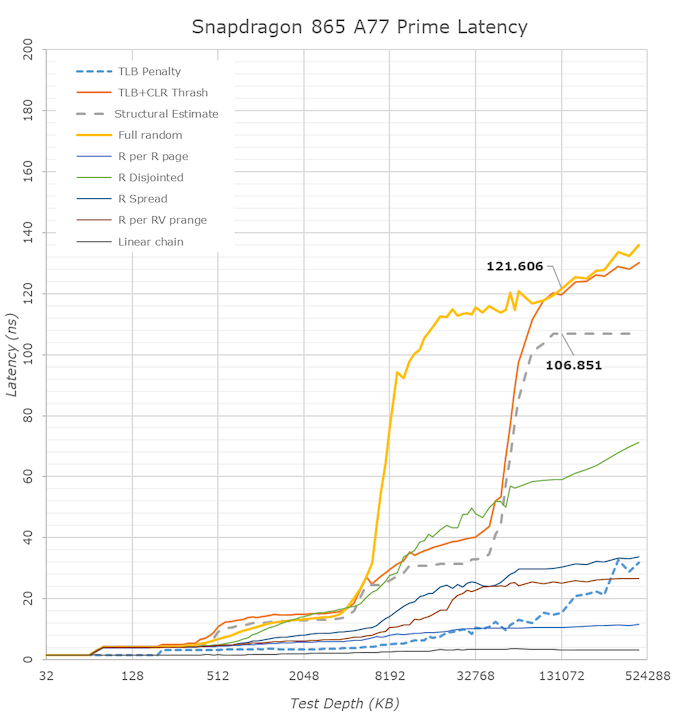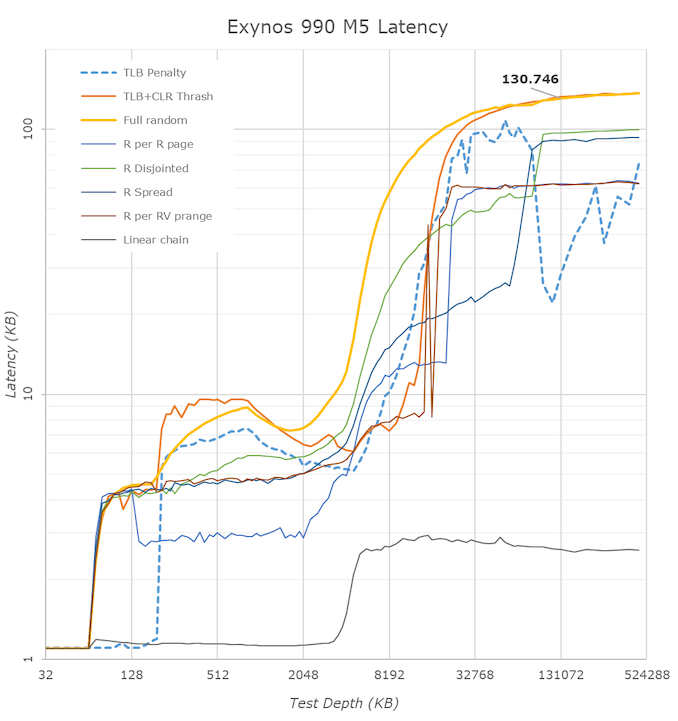The Samsung Galaxy S20+, S20 Ultra Exynos & Snapdragon Review: Megalomania Devices
by Andrei Frumusanu on April 3, 2020 9:30 AM ESTMemory Subsystems Compared
On the memory subsystem side, there’s quite a few big changes for both the Snapdragon 865 as well as the Exynos 990, as these are the first commercial SoCs on the market using LPDDR5. Qualcomm especially is said to have made huge progress in its memory subsystem, and we’re now able to verify the initially promissing results we saw on the QRD865 back in December with a production device.
And indeed, the news keeps on getting better for Qualcomm, as the new Galaxy S20 showcases even better memory results than we had measured on the reference device. The improvements over the Snapdragon 855 are just enormous and Qualcomm not only manages to catch up but very much now is able to beat the Exynos chips in terms of memory subsystem performance.
Arm very famously quotes that an improvement of 5ns in memory latency corresponds to an increase of around 1% in performance. And if that’s the case, Qualcomm will have had a ~12% improvement in CPU performance just by virtue of the new memory controller and SoC memory subsystem design. Our structural estimate in the memory latency falls in around 106 vs 124ns – most of the improvement seems to be due to how Qualcomm is now handling accesses to the DRAM chips themselves, previously attributing the bad latencies on the Snapdragon 855 due to power management mechanisms.
Samsung’s Exynos 990 also improves in memory latency compared to the Exynos 9820, but by a smaller margin than what the Snapdragon 865 was able to achieve. All latency patterns here are still clearly worse than the Qualcomm chip, and there’s some oddities in the results. Let’s zoom in into a logarithmic graph:
Comparing the Exynos 990 results vs the Exynos 9820, it’s now quite visible that the L2 cache has increased dramatically in size, similar to what we’ve described on the previous page, corresponding to the doubling of the available cache to a core from 1MB to 2MB. Samsung’s cores still have some advantages, for example they’re still on a 3-cycle L1 latency design whereas the Arm cores make due with 4-cycle accesses, however in other regards, the design just falls apart.
The TLB issues that we had described last year in the M4 are still very much present in the M5 core, which results in some absurd results such as random accesses over a 2MB region being actually faster than at 1MB. Cache-line accesses with TLB miss penalties now actually have lower access latencies in the L3 than in the L2 regions, and I have no idea what’s happening in the 16-64MB region in that test as it behaves worse than the 9820.
Examining the A76 cores of the Exynos 990, we see a much cleaner set of results more akin to what you’d expect to see from a CPU. Here we also see the 2MB SLC cache hierarchy in the 1-3MB region, meaning the Arm core cluster does have access to this cache, with the M5 cores bypassing it for better latency. Last year I had noted that the A76’s prefetchers had seen some massive improvements, and this is again evident here in the result sets of the two CPUs on the same chip as the middle cores actually handle some access patterns better than the M5 cores.
Samsung has had large issues with its memory subsystem ever since the M3 design, and unfortunately it seems they never addressed them, even with the more recent M5 core.
The Snapdragon 865 here is quite straightforward. The biggest difference to the 855, besides the improved DRAM latency, is the doubling of the L3 from 2 to 4MB which is also immediately visible. It still pales in comparison to the Apple A13’s cache hierarchy, but we do hope that the Arm vendors will be able to catch up in the next few years.













137 Comments
View All Comments
Danish_92 - Tuesday, April 7, 2020 - link
why are these big brands suddenly focusing on big cameras?surt - Tuesday, April 7, 2020 - link
I'd say they're focusing on camera GPU performance, which are the two areas of the phone where performance is not yet 'good enough'. Everything else just ... works.s.yu - Tuesday, April 7, 2020 - link
They're focusing on anything that makes a selling point that people could care about. They also focused on the haptic motors and most mid-high tier phones should vibrate better than those 3-4 years ago.watzupken - Wednesday, April 8, 2020 - link
Big brands are focusing on big cameras because they see Chinese phones, in particular Huawei, making a lot of waves in this area. Since it is very difficult to differentiate their products especially for Android phones, thus, whatever seems to rock with the consumer, every manufacturer will double down on the same features. First it was SOC, then they start spamming ram, follow by cameras, higher screen to body ratio, and now high refresh rate screen. You can tell Samsung is purely focusing on these areas I have mentioned as well.colonelclaw - Tuesday, April 7, 2020 - link
A slightly unfortunate time to launch such an expensive product. I don't know about you all, but right now I'm saving every penny I can.peevee - Wednesday, April 8, 2020 - link
"Why Samsung is able to call this a 3x telephoto module is that when cropping a 1:1 12MP picture out of it, it does end up at a 3x magnification in relation to the main camera sensor."3x magnification by the sensor would crop 8 out of 9 pixels. For 64MP original, it would be 7.1MP, not 12.
flyingpants265 - Thursday, April 9, 2020 - link
No front speakers = no buy.Crappy smartphone OS with no proper multitasking, on a phone with 16 gigs of RAM = no buy.
Can't turn off Google phoning home in software = no buy.
$999 = DEFINITELY no buy. Pay about $300 for a used S10. Don't be a sucker.
StrangerGuy - Thursday, April 9, 2020 - link
I just ordered a brand new SD845 Note 9 for $350 to replace my current Exynos Note 9 with OLED black banding issues out-of-warranty. Replacing the screen aftermarket would cost $250 alone.Anyway, I have no idea why anybody would want to pay $1000+ of IQ deficiency taxes for the current breed of half-baked Samsung phones. Even their home appliances and TVs are also rubbish in terms of value per dollar.
helloworld_chip - Sunday, April 12, 2020 - link
Do we have 990 kirin 5G GPU efficiency data for comparison? Would be glad to see if it also shows big efficiency improvements over the 4G version.snarfbot - Sunday, April 12, 2020 - link
How does the 855+ stack up